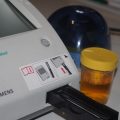Farxiga, also known as dapagliflozin, is a medication commonly prescribed to manage type 2 diabetes by improving blood sugar control. This sodium-glucose cotransporter 2 (SGLT2) inhibitor works by promoting the elimination of excess glucose through urine.
The USFDA recently expanded the use of Farxiga for the treatment of heart failure (HF) across the entire range of left-ventricular ejection fraction (LVEF). While Farxiga is effective in its intended purpose, its mechanism of action raises questions about hydration and water intake. Understanding the relationship between Farxiga and hydration is crucial for individuals using the medication to maintain their overall health and well-being.
Farxiga and Its Mechanism of Action
Farxiga operates by inhibiting SGLT2 receptors in the kidneys, which are responsible for reabsorbing glucose back into the bloodstream. By blocking these receptors, Farxiga allows excess glucose to be excreted through urine. While this is a beneficial action for managing blood sugar levels, it is also associated with increased urine output. Consequently, individuals taking Farxiga may experience an elevated risk of dehydration due to the loss of fluids through frequent urination.
The Importance of Hydration
Hydration is a fundamental aspect of overall health, and its significance becomes even more pronounced when taking medications like Farxiga. Water is essential for various bodily functions, including temperature regulation, nutrient transportation, and waste elimination. Proper hydration is vital for maintaining cardiovascular health, supporting kidney function, and ensuring the smooth operation of metabolic processes.
When it comes to managing diabetes, hydration plays a key role in mitigating potential complications. Dehydration can lead to an increase in blood sugar levels, as the concentration of glucose in the blood rises when the body lacks sufficient fluids. This underscores the importance of striking a balance between the therapeutic benefits of Farxiga and maintaining adequate hydration to support overall health.
Determining Individual Water Needs
The optimal amount of water one should consume can vary based on factors such as age, weight, activity level, climate, and overall health. The National Academies of Sciences, Engineering, and Medicine recommends a daily water intake of about 3.7 liters (125 ounces) for men and 2.7 liters (91 ounces) for women, including fluids from all sources such as beverages and food. However, individual requirements may differ, and adjustments may be necessary for those taking medications like Farxiga.
Factors influencing water needs include:
- Body Weight: Generally, the larger the body, the more water it requires. A simple rule of thumb is to consume half an ounce to an ounce of water for each pound of body weight.
- Activity Level: Physical activity increases fluid loss through sweating and breathing. Individuals engaging in regular exercise may need additional water to compensate for these losses.
- Climate: Hot and humid weather can lead to increased sweating, requiring higher water intake to prevent dehydration.
- Medical Conditions: Certain medical conditions, including diabetes, may affect fluid balance in the body. Individuals with diabetes are often advised to monitor their water intake more closely.
The Farxiga-Dehydration Connection
The primary concern regarding hydration arises from Farxiga’s impact on urine output. The medication promotes the elimination of glucose and, subsequently, water through urine. While this can be advantageous for reducing blood sugar levels, it also raises the risk of dehydration, especially if individuals do not compensate by increasing their fluid intake.
It is crucial for those prescribed Farxiga to be aware of the symptoms of dehydration, which may include:
- Dark yellow urine
- Dry mouth and throat
- Dizziness or lightheadedness
- Rapid heartbeat
- Sunken eyes
- Reduced urine output
If any of these symptoms are experienced, it is essential to increase fluid intake promptly. Consulting with a healthcare provider about individual hydration needs and potential adjustments to Farxiga dosage or timing is advisable.
Strategies for Staying Hydrated While Taking Farxiga
Maintaining adequate hydration while on Farxiga requires a proactive approach. Here are some strategies to ensure proper fluid balance:
- Regular Water Intake: Make a conscious effort to drink water regularly throughout the day. Carry a reusable water bottle to encourage consistent hydration.
- Monitor Urine Color: Pay attention to the color of urine. Light yellow or pale straw indicates proper hydration, while dark yellow may suggest dehydration.
- Adjust Fluid Intake: Consider factors such as activity level, climate, and overall health when determining daily fluid intake. Adjustments may be necessary on days with increased physical activity or in hot weather.
- Incorporate Hydrating Foods: Consume water-rich foods such as fruits and vegetables to contribute to overall fluid intake.
- Limit Dehydrating Substances: Reduce the intake of caffeinated and alcoholic beverages, as they can contribute to dehydration.
- Consult with Healthcare Providers: Regularly communicate with healthcare providers about any concerns related to hydration, especially if experiencing symptoms of dehydration or considering changes to fluid intake.
The Role of Healthcare Providers
Healthcare providers play a pivotal role in guiding individuals on Farxiga about managing hydration. It is essential for patients to openly discuss their concerns, experiences, and any symptoms they may be facing. Healthcare providers can:
- Assess Individual Needs: Considering factors like age, weight, medical history, and lifestyle, healthcare providers can help determine an individual’s specific hydration requirements.
- Monitor Side Effects: Regular check-ups allow healthcare providers to monitor the impact of Farxiga on hydration levels and make necessary adjustments to medication or fluid recommendations.
- Educate Patients: Offering information and guidance on the importance of hydration, potential signs of dehydration, and strategies for maintaining proper fluid balance is crucial for empowering patients to make informed decisions.
Conclusion
While Farxiga is an effective medication for managing type 2 diabetes, its impact on fluid balance underscores the importance of maintaining proper hydration. Individuals prescribed Farxiga should be proactive in monitoring their fluid intake, adjusting it based on their unique needs and circumstances. Collaborating with healthcare providers to address any concerns or symptoms of dehydration is vital for achieving a balance between the therapeutic benefits of the medication and overall health and well-being. By prioritizing hydration and staying informed, individuals can optimize their diabetes management while taking Farxiga.





